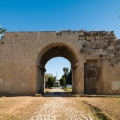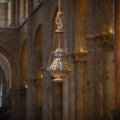Amidst the dramatic peaks of the Montserrat mountain range, near Barcelona, stands Montserrat Abbey. Founded in 1025, this Benedictine monastery will celebrate its 1000th anniversary in 2025, marking a significant milestone not only in its own history, but also in the cultural and religious landscape of the region.
From humble beginnings to a thriving powerhouse
Before its official founding, Montserrat served as a pilgrimage site for centuries. Legend has it that Montserrat was founded on the 9th century, after the discovery of a hidden statue of the Virgin Mary in a mountain cave. This legend spurred the construction of a church and the gradual formation of a monastic community. In 1025, Abbot Oliba, a prominent Catalan religious figure, formally established the Benedictine monastery and dedicated it to the “Black Madonna” of Montserrat –la Moreneta.
In the centuries that followed, Montserrat Abbey became a vibrant center of religious, cultural and intellectual life. The monks devoted themselves to prayer, scholarship, and service, meticulously copying and preserving ancient manuscripts, composing music, and even pioneering a printing press in the 15th century. The abbey welcomed pilgrims and travelers, offering sanctuary and spiritual guidance.
Enduring through turbulent times
Montserrat Abbey has endured virtually everything. During the Napoleonic Wars, French troops sacked the abbey, causing significant damage to the library and artwork. The Spanish Civil War brought further destruction when Republican forces bombed the abbey. Despite these challenges, the monks persevered, rebuilding their community and preserving their heritage.
A Sanctuary of Art and Music
Beyond its spiritual significance, Montserrat Abbey is renowned for its artistic treasures. The basilica houses a magnificent collection of religious art, including the iconic statue of the Black Madonna, a Romanesque masterpiece carved from dark poplar wood. The abbey’s Escolania de Montserrat, one of the oldest boys’ choirs in Europe, fills the centuries-old walls with the ancient melodies of Gregorian (and not so Gregorian) chant.
A beacon for the future
Today, Montserrat Abbey continues to thrive as a vibrant community of Benedictine monks dedicated to prayer, scholarship, and service. The Abbey welcomes visitors from around the world, providing a haven for spiritual reflection and cultural enrichment. Now, in its 11th century, Montserrat Abbey stands as a testament to the enduring power of faith, culture, and community.
Notable Visitors
Throughout its history, Montserrat Abbey has hosted many notable figures, including
Pope John Paul II: In 1982, Pope John Paul II visited Montserrat Abbey and venerated the statue of the Black Madonna.
Saint Ignatius of Loyola: In 1522, Saint Ignatius of Loyola spent three days at Montserrat Abbey, which played a significant role in his spiritual conversion.
On the night of March 24, he left behind his past of nobility and service to the emperor, to surrender his weapons to the Virgin of Montserrat (leaving his sword and dagger on the altar) and dress in the garb of a poor pilgrim. Dressed as a beggar, he went down to Manresa to live there for almost a year. During that time, St. Ignatius returned to Montserrat several times seeking spiritual advice and learning from the monks about prayer and the interior life, following the Devotio Moderna. The monks kept very good memories of this “madman for Christ”, as they used to call him. The statue of the pilgrim Ignatius with his sword and the black stone with the inscription of the place of the prayer vigil bear witness to the passage of St. Ignatius through this place.
Salvador Dalí: The famous surrealist artist Salvador Dalí was baptized at Montserrat Abbey in 1904.
Preserving Catalan Heritage
Montserrat Abbey has played an important role in preserving the Catalan language and culture. The monks have published numerous books and articles in Catalan, and the Escolania de Montserrat choir also performs traditional Catalan music. The abbey also houses a library with an extensive collection of Catalan literature.
Commitment to sustainability
In recent years, Montserrat Abbey has made a strong commitment to sustainability. The monastery has installed solar panels to generate electricity, uses recycled materials whenever possible, and promotes composting and other environmentally friendly practices.
The 1000th anniversary of Montserrat Abbey is a momentous occasion to celebrate its rich history, its significant contributions to art and culture, and its continuing role as a beacon of faith, culture, hope, and commitment. As the Abbey is about to enter its next millennium, it continues to inspire and enrich the lives of countless people around the world.




